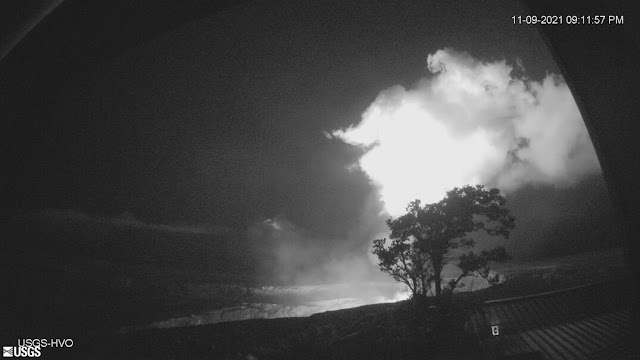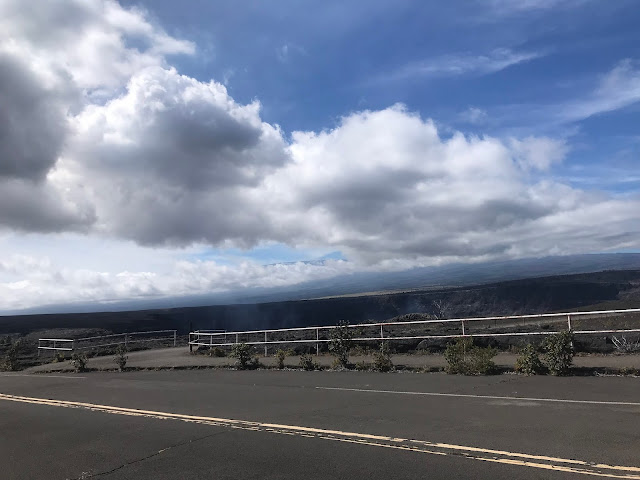I understand: Each day we live is a smaller (and smaller) fraction of our total. Some posit thatʻs why Time seems to pass faster and Faster and FASTER as we age. But really?! November already? I wake up, coffee and chores, most times go walk, come home, putter and chores, and work research, and before I know it, gotta make dinner.
Our dry spell is deciding what to do. It was a blustery Thursday last, after two and a half weeks of no rain blue clear skies. Air is chill in the mornings as we wait, observe, and adjust as necessary. Skies have been decorated with high high wisps of cirrus, their filters helping dim the sun and cool the air. Bloomings continue in the yard, with 11 old-fashioned orange epidendrums spiking, three aloe, and lots of ʻōpelu, though the latter are about three-fourths pau bloom. Oh and the random pōpōhau (hydrangea) popped up too. But...Howʻs THIS for spectacular??? (mahalo sz)
like below, silhouetted against the sky. The salmon-colored "leaves" are bracts surrounding inflorescences, those three club-like structures at center. Each flower is a tiny bump on those.
ʻIeʻie is of interest and is important to us because in some traditions it is the highest on the kuahu, the hula altar dedicated to Laka, the elemental whose kuleana is hula. Our Lā Kuahu, the annual day for rededicating the Kuahu was last week Saturday.
Traditions continue...
A "tradition", or some may say a practice maintained over generations the world over, is stewarding the land, the ʻāina. Caring for it as it cares for us. ʻĀina is more than simply "the land". It is that which sustains us.
In Andrews Dictionary of 1865:
AI-NA
s. Ai, to eat, enjoy, and na, contraction of ana (the participial termination of words equivalent to Eng. ing. See Gram. § 204,2.) An eating; the means of eating, i. e., the fruits of the land; hence,
1. Land generally; a farm; a field; a country; an island. In this sense it is SYN. with moku, or mokupuni; elua inoa i kapaia ma ka mokupuni, he moku kekahi, a he aina kekahi, an island has two names, moku is one, and aina is the other. D. Malo. 7:1.
2. Any taxable privilege, as the right of fishing, the right to sell things in market, &c.
3. Any means of obtaining a living; e kii au e hao i kela waiwai, no ka mea, o ko'u aina no o ka hao wale aku, I will go and rob that property, because it is my means of living to rob. Haw. Hist.
And in the Pukui and Elbert dictionary:
ʻāina
n. Land, earth. Cf. ʻai, to eat; ʻaina, kamaʻāina. Kō nā ʻāina like ʻole, belonging to foreign lands, foreign, international. ʻĀina hoʻoilina, inherited property or estate. Ua mau ke ea o ka ʻāina i ka pono (motto of Hawaiʻi), the life of the land is preserved in righteousness. (PEP kaainga.)
In conversations with those more learned about these things than I, itʻs been shared that "land, earth"...is, if one thoughtfully reads Andrews, "that which sustains us", or as he says, "the means of eating". Itʻs not simply the "land", it is livelihood, and something many of us revere and have deep aloha for, because it provides. For a mahiʻai, a cultivator or farmer, the land is ʻāina; for fisherfolk, the ocean is ʻāina; for a kahuna kālai waʻa, a person skilled in canoe carving, a koa tree is ʻāina. And even, if one is a robber as in Andrews 3. above, the robbing is ʻāina.
And, I suppose, following this line of thinking, a kumu niu, a coconut tree, is ʻāina. Its multitude of uses makes life and livelihood possible for many. Timber for building, strong and durable cordage, food, fuel, thatch, brooms, cups, baskets, sieves, oil, liquor, drums, water, milk, its uses are many and critically important.
Along Waiolama in Hilo, below taken from outside Kūhiō Grille, the tall one distant center.
Note that it was 92.5 feet tall 42 years ago! Iʻll update you when I get a current height. Look good below, Iʻm standing next to it.
Below, itʻs the crown in the triangle formed by the banyan tree / lau niu (frond) / kumu (trunk), on the edge of Waiolama as seen from the Pauahi Street bridge. Downtown Hilo and Maunakea in the distance.
GoLook! And to think that on Samarang (Palmyra), to our south, niu is an invasive species!
 |
| US Fish and Wildlife Service |
The stories of niu on Samarang are fascinating. GoGoogle...
And yes, Pelehonuamea continues to create...The photo below was at the last full moon mid-Octoberish, by Dan OʻConnor. Wow.
To me, this is the perfect time of day, and the perfect place. Sun rising, Halemaʻumaʻu still in shadow so pele is easily seen, Maunaloa rising-sun pink, ʻŌhaikea a touch of green, and of course, nani wale a ka mahina! Beautiful is the moon!
The same scene, minus mahina, October 30 (thanks rb!)
And below, again from rb on 103021, a different vantage point, near Volcano House. That bright hōkū upper right is Keoe (Vega). Thanks hf for the ID!
And yes, the drama of an orange night, captured so accurately by those Volcano School painters 100+ years ago, and the photos above are...dramatic. And the adventure of a nighttime walk lit by the fires of Pele is undeniably memorable, but...I prefer to see context. Thus subdued dawn light is my favorite.
So. The decline in output is slow, but still a decline. For now.
The loko ahi slowly diminishes in size, and the outlet is a bit lazier. For now.
And all is quiet on the ōlaʻi front. Thankfully. For now. Below screenshot at 1148a today. And yes, the base image is definitely out of date. We get to revisit the loko waiwelawela held in the cup of Halemaʻumaʻu...that short-lived but amazing lake of hot water...in case you forgot.
And finally for today, another memory prod, for those who werenʻt here, canʻt remember, donʻt know...another favorite from HVO, on November 3, 2021 by LDS.
Former roadway (middle left) that led to the Halemaʻumaʻu Parking Lot disappears...
Tis all an amazement. Truly and always.
Till next time, as always, with aloha,
BobbyC
maniniowali@gmail.com










































